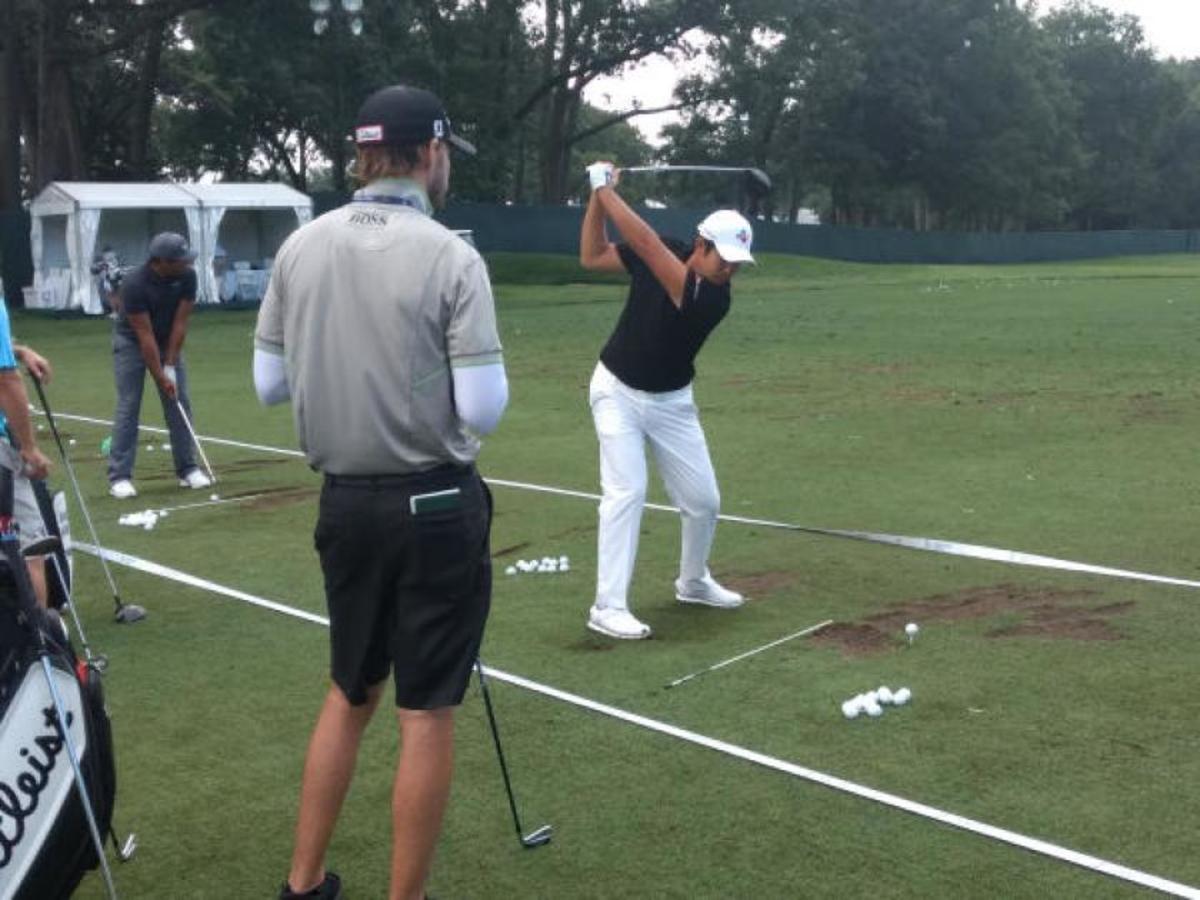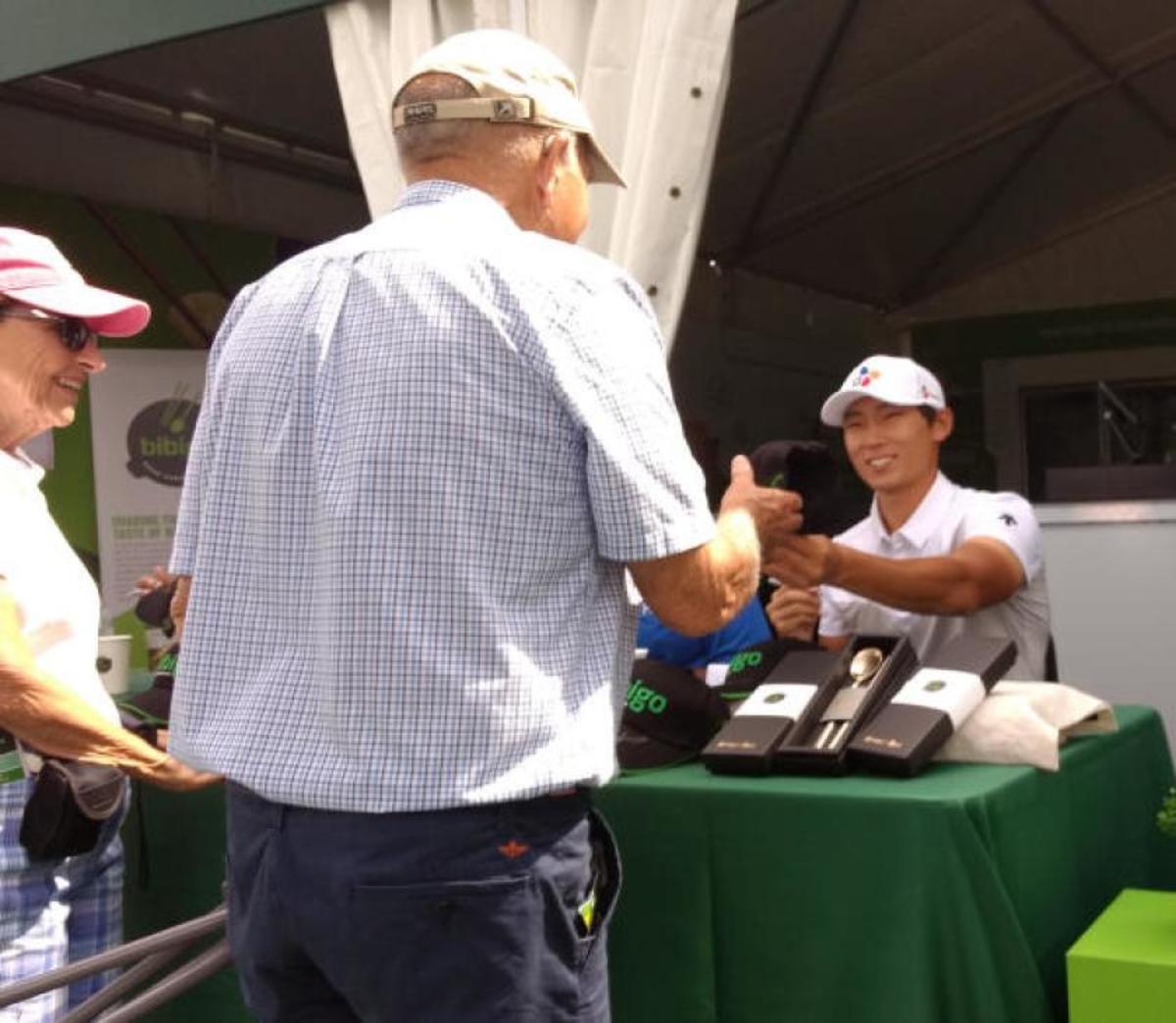Korean men show they've got game, too

PARAMUS, N.J. – By their food and their games shall ye know them, say students of world cultures. Not one to buck sage advice, I am sitting with four of South Korea’s best male golfers at a picnic table by the 15th hole at Ridgewood Country Club in this over-the-Hudson-River suburb of New York. We are eating dak kang jung, chili-pepper-laden chunks of lightly breaded chicken.
These players – Sung Kang, Si Woo Kim, Whee Kim and Byeong Hun An (known as Ben) – have 11 worldwide victories among them. Kang, 30, is the oldest. Si Woo Kim, 23, won the Players Championship in 2017. They gathered at midday Wednesday, the day before the first round of the Northern Trust (tee times), the first of four FedEx Cup playoff events, to sign autographs and chow down on Korean delicacies with their fans.
So, we have the food covered. Now the games.
What is it about Korean golfers? They have methodically and imperturbably established golf footholds around the world. Eight PGA Tour members are identified in the Tour’s media guide as Korean, more than any other Asian country. At least four more were born in South Korea but identify as American, having moved here at a young age, or were born in the U.S. to Korean parents.
On the LPGA, four of the top-10 money leaders are Korean: No. 2 Sung Hyun Park, No. 3 So Yeon Ryu, No. 7 Jin Young Ko and No. 8 Inbee Park. That foursome has 11 major victories among them, led by Inbee Park’s seven. One of the most identifiable players on the LPGA, Michelle Wie, is the American child of Korean parents. Of about 220 LPGA cardholders, 23 play under the flag of South Korea.
“It’s really competitive in Korea,” said An, the 2009 U.S. Amateur champion. “We watched Y.E. [Yang] beat Tiger [Woods in the 2009 PGA Championship] and K.J. [Choi] win the 2011 Players. If they can do it, why can’t more of us?”

MORNING READ/ADAM BARR
South Korea’s Byeong Hun An goes to work on the range before the PGA Tour’s Northern Trust event at Ridgewood Country Club in Paramus, N.J.
Yang, 46, and Choi, 48, were the trailblazers, at least for men. But the explosion in Korean golf worldwide is more often traced to an 11-week run in 1998 by a shy young woman named Se Ri Pak. Then a few months short of her 21st birthday, Pak won the McDonald’s LPGA Championship, a major, for her first LPGA title. Seven weeks later, she won the U.S. Women’s Open in a heart-racing 20-hole playoff against amateur Jenny Chuasiriporn. In the next three weeks, she won two more tournaments. By the time she finished her career in 2016, she had won a total of 25 LPGA titles, including three more majors.
By 2008, there were 47 Korean players on the LPGA, leading to awe among many who follow golf – and enough frustration among a few to move them to insensitive, some say racist, observations.
The only people who didn’t get lathered were the Korean players themselves, who just kept going about their business. And winning. Those who know say it’s a cultural thing.
“Everywhere in the world, some Korean guy is winning; men and women are winning golf tournaments,” Kevin Na said in a media conference Tuesday. Na, a two-time PGA Tour winner, came to the United States from Korea at age 8 and was raised near San Diego. “Obviously golf being a very popular sport in Korea, and as many junior golfers are playing and how much they practice, it's incredible. They are hard-working, and I think that's kind of the Korean mentality: they don't give up. They work hard, whether that's overtime or whatever it takes.”
“When you have that competitive nature, that culture that you have, I think you end up growing really great athletes,” said James Hahn, also a two-time PGA Tour winner, in another Tuesday media conference. His parents brought him to the U.S. from South Korea when he was 2, and he grew up in the Bay Area. “I'm not knocking the American culture at all, but we don't give out participation rewards in Korea. It's like for us, I guess the running joke is: If you don't win, you get cold rice for dinner.”

MORNING READ/ADAM BARR
South Korea’s Whee Kim demonstrates how to win over U.S. golf fans: with a smile and an autograph.
Could the PGA Tour be the next site of Korean golf dominance? It’s not as likely, although Na, Hahn and others expect the strong showing by Korean players to continue. Young Korean men owe 21 months of compulsory military service, which can interrupt a career, while Korean women do not. Also, as in Japan, women’s professional golf is more popular in Korea than the men’s game, and that influence counts. Soccer, baseball and basketball compete for young Korean men’s attention, but not for women’s. More often, the families of athletic young Korean women see golf as an opportunity to get ahead.
And then there’s timing. It may have been better for women in the wake of Se Ri Pak than it is now for men. So, while it may not be reasonable to expect dominance, the outlook is still good.
“At this point in time, the depth and breadth of global golf talent is the greatest it’s ever been,” said Ty Votaw, the PGA Tour’s executive vice president of global business affairs and a former commissioner of the LPGA. “So, it’s difficult for any one country to break through and dominate. But having that level of talent globally, and in Asia specifically, portends a very bright future for global golf.”
By their games, we shall find out.
Adam Barr has surveyed golf for 25 years as a print and broadcast journalist (Golfweek, Golf Channel), an equipment company executive, and with the USGA as director of communications and its museum. He lives in Basking Ridge, N.J. Email: adambarr1@gmail.com; Twitter: @ABNarratesBooks
